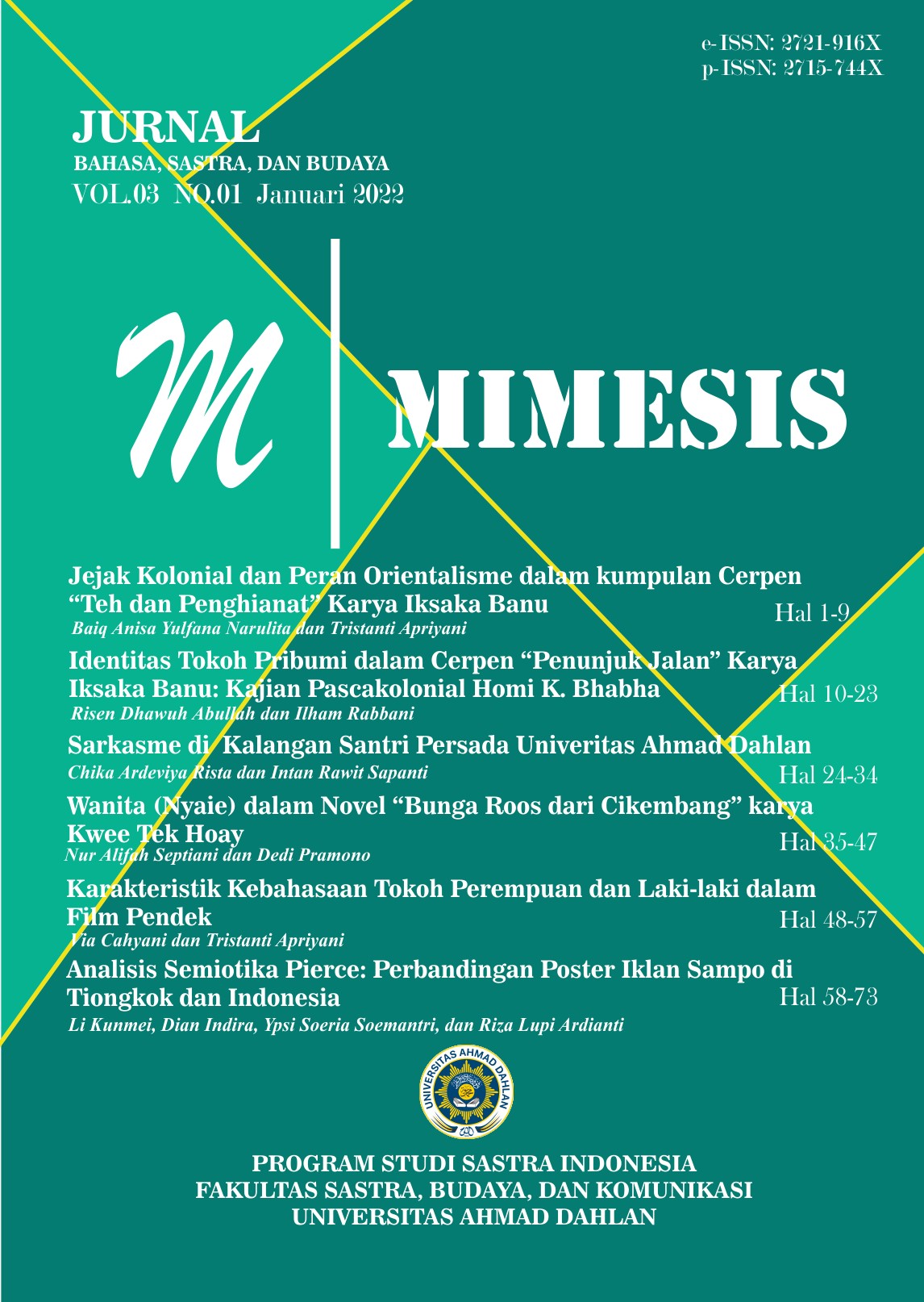ANALISIS SEMIOTIKA PIERCE: PERBANDINGAN POSTER IKLAN SAMPO DI TIONGKOK DAN INDONESIA
DOI:
https://doi.org/10.12928/mms.v3i1.5560Keywords:
Shampoo Advertisement, Indonesia-China, Semiotics, Character, SocietyAbstract
Advertisements are packaged in such a way that it is very influential to convey messages and at the same time influence or suggest products to the public. In shampoo advertisements from one country to another, there are cultural peculiarities of the people. This research has a problem formulation, namely the character of shampoo advertising culture in China and Indonesia. In solving the problem formulation, this research uses Pierce's semiotic theory using data in the form of advertisements for the Pantene, Clear, and Sunsilk shampoo brands. The analysis is carried out with a qualitative method. The results of this study show that shampoo advertisements in China and Indonesia in general have similarities with displaying a picture of a woman, but both have their own character that shows a picture of the people of their respective countries.
References
Aristyani, I. A. R., & Yasa, N. N. K. (2013). Perbandingan brand equity roduk sampoo merek Sunsilk dengan merek Pantene. Jurnal Manajemen dan Kewirausahaan. Vol 15.
Dewi, M. C. (2013). Representasi pakaian muslimah dalam iklan, analisis semiotika Charles Sanders Pierce pada iklan kosmetik Wardah di Tabloid Nova. Jurnal Profetik: Jurnal Komunikasi. No 2.
Hoed, B. H. (2011). Semiotik dan dinamika sosial budaya. Komunitas Bambu.
Kasali, R. (1995). Manajemen periklanan, konsep dan aplikasinya di Indonesia. Pustaka Utama Grafiti.
Kridalaksana, H. (1988). Beberapa prinsip perpaduan leksem dalam bahasa Indonesia. Penerbit Kanisius.
Kuswarno, E. (2009). Metode penelitian komunikasi. Widya Padjajaran.
Mohamed, Z. M., Majid, A. H., & Ahmad, N. (2010). Tapping new possibility in accounting research, in qualitative research in accounting, Malaysian case. Penerbit Universiti Kebangsaan Malaysia.
Nöth, W. (1995). Handbook of semiotics. Indiana University Press.
Piliang, Y. A. (2010). Hipersemiotika: Tafsir Cultural Studies atas Matinya Makna. Jalasutra.
Pondaag, A. F. (2013). Analisis semiotika iklan A Mild Go Ahead versi “Dorong Bangunan” di telivisi. Jurnal Acta Diurna. Vol 1.
Ratna, N. K. (2008). Teori, metode, dan teknik penelitian sastra. Pustaka Pelajar
Sobur, A. (2003). Semiotika komunikasi. Remaja Rosdakarya.
Wulandari, S. & Siregar, E.D. (2020). Kajian Semiotika Charles Sanders Pierce: Relasi Trikotomi (Ikon, Indeks dan Simbol) dalam Cerpen Anak Mercusuar Karya Mashdar Zainal. Jurnal Titian: Ilmu Humaniora. Vol 04. No 1..
Sumber Internet
Muslimah, F. (2016.) “Sunsilk clean and fresh: Cocok untuk perawatan rambut hijaber”. Diakses pada https://www.gomuslim.co.id/read/produk/2016/03/14/12/sunsilk-clean-and-fresh-cocok-untuk-perawatan-rambut-hijaber.html
Sebulhocky (2016). “Atasi ketombe anda dengan sampo”. Diakses pada laman https://kesehatan316.wordpress.com/2016/11/09/atasi-ketombe-anda-dengan-clear-shampo/
Anonim. Tidak ada tahun. “Pantene Shampoo Anti Lepek 290 ml”. Diakses pada laman https://shopee.co.id/Pantene-Shampoo-Anti-Lepek-290-ml-i.11487927.885967236https://shopee.co.id/Pantene-Shampoo-Anti-Lepek-290-ml-i.11487927.885967236.
Downloads
Published
Issue
Section
License
Copyright (c) 2022 Li Kunmei, Dian Indira, Ypsi Soeria Soemantri, Riza Lupi Ardiati

This work is licensed under a Creative Commons Attribution-ShareAlike 4.0 International License.
License and Copyright Agreement
In submitting the manuscript to the journal, the authors certify that:
- They are authorized by their co-authors to enter into these arrangements.
- The work described has not been formally published before, except in the form of an abstract or as part of a published lecture, review, thesis, or overlay journal.
- That it is not under consideration for publication elsewhere,
- That its publication has been approved by all the author(s) and by the responsible authorities tacitly or explicitly of the institutes where the work has been carried out.
- They secure the right to reproduce any material that has already been published or copyrighted elsewhere.
- They agree to the following license and copyright agreement.
Copyright
Authors who publish with Mimesis agree to the following terms:
- Authors retain copyright and grant the journal right of first publication with the work simultaneously licensed under a Creative Commons Attribution License (CC BY-SA 4.0) that allows others to share the work with an acknowledgment of the work's authorship and initial publication in this journal.
- Authors are able to enter into separate, additional contractual arrangements for the non-exclusive distribution of the journal's published version of the work (e.g., post it to an institutional repository or publish it in a book), with an acknowledgment of its initial publication in this journal.
- Authors are permitted and encouraged to post their work online (e.g., in institutional repositories or on their website) prior to and during the submission process, as it can lead to productive exchanges, as well as earlier and greater citation of published work.











